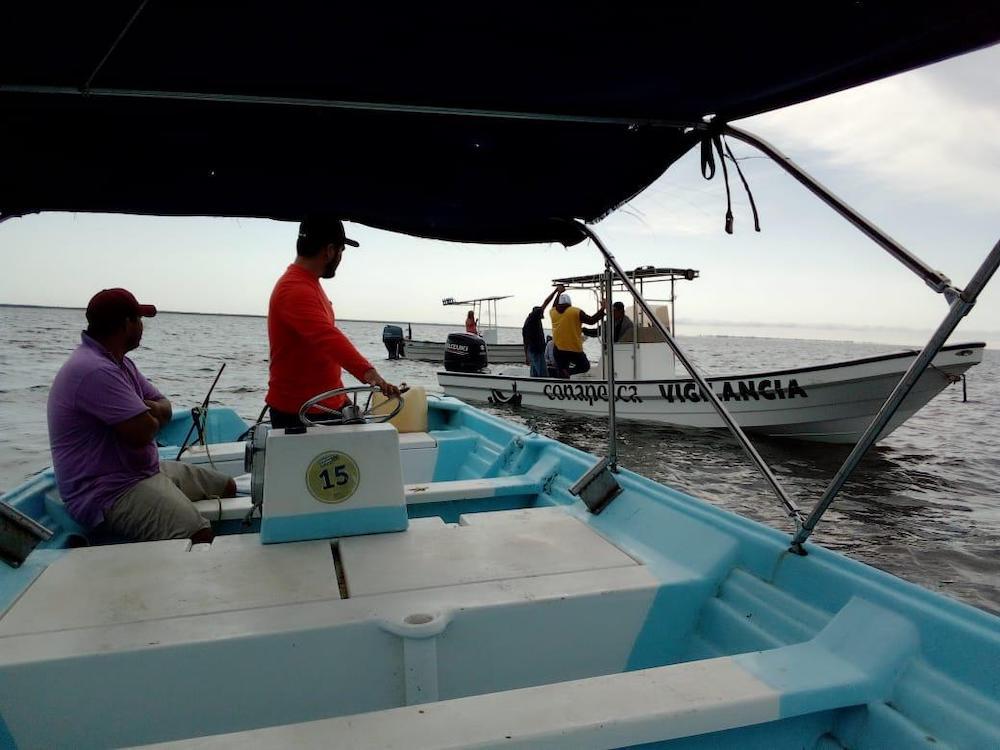In early September, Juan Diego Medina, leader of a group of cooperatives in Altata, Sinaloa, requested help from the National Aquaculture and Fisheries Commission (Conapesca) to address the intrusion of poachers.
The president explained that during the shrimp ban, which runs from May to September 15, it is common to request support from the authorities at least twice a month to arrest illegal fishermen, but they do not receive any type of resource for these tasks from Conapesca.
“We do the surveillance ourselves as a cooperative and we ask for Conapesca's support to do the tours and take it more seriously,” said the president of the Federation of Cooperative Fishery Production Societies of Bays and Marine Waters of Altata and Ensenada el Pabellón, in Sinaloa.
The logistics take place in an area where insecurity forces fishermen to ask for help from the authorities to do the work they cannot do alone. It is the inspectors of Conapesca who have the power to fine and the members of the Secretariat of the Navy (Semar) to arrest those who commit irregularities.
A similar dynamic occurs with the lobster fishery in Punta Allen, Quintana Roo, where the fishing cooperative of Vigía Chico performs inspection and surveillance tasks on a monthly basis.
When it is known that illegal fishermen are taking advantage of the ban, which runs from March to June, they decide to ask for help from the authorities, said Roger Ancona, the cooperative's surveillance secretary.
“We are not super men to catch people alone, we need Conapesca and higher authorities, with the Navy and others to intervene,” he said.
“In Veda then a lot of people don't go fishing, so stealthy people take advantage of that opportunity to see what to go fishing... But we in Veda do that surveillance and sometimes in season,” he added.
Currently, the operations of the Vigía Chico cooperative are carried out by two people plus the president of surveillance.
The secretary said that the inspectors of Conapesca do not arrive in the community if they are not requested, despite the fact that in meetings they have been explicitly told that they would like to be accompanied on a routine basis.
The resources used by Conapesca to combat illegal fishing have been diminishing since the beginning of this administration.
In 2019, the agency exercised 152 million 835 thousand pesos to combat illegal fishing, an amount that decreased 34.5% in 2021, according to open transparency data published by Conapesca.
In 2021, 44% of resources for inspection and surveillance were spent on analog and digital signal conduction services; 29.6% on the leasing of marine and land vehicles; and 11% on fuels and lubricants, according to the three main areas exercised in accordance with open data.
With the arrival of the present administration, support for illegal fishing began to diminish. Today, the cooperatives in Altata, Sinaloa, do not receive federal money for inspection and surveillance, but from the Sinaloa government, Medina explained.
“For the six months of the ban, nothing can be 150 thousand or 200 thousand pesos, so we as the (fishing) Federation distribute it to the five fishing fields giving them gas and paying the person who is up there in the boat... the truth is 200,000 is not enough for the time we have to take care of,” said Medina.
While the budget spent to combat illegal fishing languishes, complaints of illegal fishing received reported by the authority have also decreased, from 450 in 2019 to 375 in 2021, a drop of 16%.
Of the 1,610 complaints received over the three years, 70.6% were for illegal capture, 22% for illegal marketing, 1.6% for illegal capture, and the rest in others.
The possibility of knowing these data is due to the transparency of inspection and surveillance.
The Causa Natura research center evaluates the level of this transparency. In December 2021, the results of the Natural Resources Transparency Index (ITRN) were published,
On a scale from 0 to 1, where 1 is the highest score, public inspection and surveillance data obtained 0.42 in active transparency, the obligation of public bodies to publish relevant information; 0.08 in proactive transparency, activities that promote the generation of information in addition to that required by law; and 0.74 in open data, without rights that can be used by anyone freely.
Lack of resources
Today, Conapesca has 85 boats and 121 land vehicles to carry out inspection and surveillance tasks, according to the Conapesca inspection and surveillance inventory.
The work is titanic when you think that with these resources you must monitor the 3 million 149 thousand 920 square kilometers of the area of the exclusive economic zone.
For fishermen, contacting Conapesca is also a way for this institution to ask for help from members of the Semar.
“In fact, because they support us with security elements, in case something happens that you don't expect, then we have one or two sailors, we're going to do operations, in case we see something illegal,” Ancona said.
Although a bill to transfer the powers of inspection and surveillance to Semar from Conapesca to Semar has not yet been approved, in fact these changes could have already started, according to statements made at the time by the former head of the fishing agency Raúl Elenes.
Through requests for information, Causa Natura revealed that Semar increased the number of illegal fishing insurances by 426% from 2020 to 2021, however, when it comes to insured kilos, the agency insured 3.4% less in 2021 than in 2020. This would show, according to experts consulted, a tendency for Marines to carry out operations on coastal fishing vessels, rather than industrial ones.



Comentarios (0)